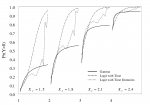Citation:
James E Alt, Gary King, and Curtis Signorino. 2001. “Aggregation Among Binary, Count, and Duration Models: Estimating the Same Quantities from Different Levels of Data.” Political Analysis, 9, Pp. 21–44. Copy at https://tinyurl.com/y2lrvn4l
| Article | 306 KB |
